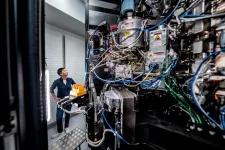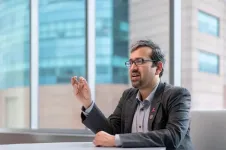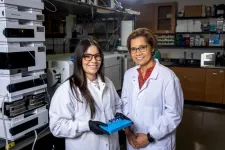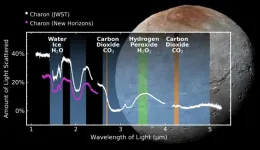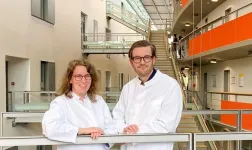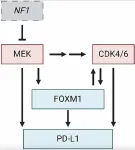(Press-News.org) As artificial intelligence continues to expand its footprint across society, some researchers are raising questions about the potential negative impact of this technological transformation.
Associate professor Mar Hicks and assistant professor Jess Reia of the University of Virginia’s School of Data Science are partnering with Tamara Kneese and the Data and Society Research Institute to examine this critical issue in a project that the National Science Foundation recently awarded a two-year, $300,000 grant.
Working with the Data and Society Research Institute, Hicks and Reia will examine what effects large data centers that are built by AI companies have on the physical environment and community life in the areas in which they reside.
While the carbon costs of this infrastructure are being assessed by some AI developers, other concerns have received comparatively little attention, including those related to electronic waste and land, energy, and water use.
The research team will work directly with affected communities to help better understand these issues and ensure that their views are being heard and accounted for by governments as they formulate AI regulations and policies.
Using participatory methods, the project team will conduct interviews with stakeholders, as well as organize workshops and pilot studies, all aimed at developing frameworks for assessing AI’s impact on the environment and society that are based on the experiences and knowledge of those most affected.
The grant is part of NSF’s Responsible Design and Deployment of Technologies program, an initiative that is providing more than $18 million of support to 44 multidisciplinary, multi-sector research teams across the country.
This project will build on work and research Hicks and Reia have done in recent years.
Hicks, who joined the School of Data Science in 2023, co-organized a conference this summer with UVA history professor Erik Linstrum, where experts from a variety of fields in academia and industry submitted papers and shared their research on lessons from history that can guide our current approaches to dealing with the social and environmental impacts of AI.
A follow-up virtual conference, which will be open to the public, is planned for Dec. 6.
Reia, who came to the School of Data Science in 2021, also serves as faculty co-lead for the Karsh Institute’s Digital Technology for Democracy Lab. Earlier this year, UVA’s Environmental Institute announced it would fund a project co-led by Reia exploring environmental and digital rights issues raised by the incorporation of big data systems into automobiles.
As artificial intelligence continues to expand its footprint across society, some researchers are raising questions about the potential negative impact of this technological transformation.
Associate professor Mar Hicks and assistant professor Jess Reia of the University of Virginia’s School of Data Science are partnering with Tamara Kneese and the Data and Society Research Institute to examine this critical issue in a project that the National Science Foundation recently awarded a two-year, $300,000 grant.
Working with the Data and Society Research Institute, Hicks and Reia will examine what effects large data centers that are built by AI companies have on the physical environment and community life in the areas in which they reside.
While the carbon costs of this infrastructure are being assessed by some AI developers, other concerns have received comparatively little attention, including those related to electronic waste and land, energy, and water use.
The research team will work directly with affected communities to help better understand these issues and ensure that their views are being heard and accounted for by governments as they formulate AI regulations and policies.
Using participatory methods, the project team will conduct interviews with stakeholders, as well as organize workshops and pilot studies, all aimed at developing frameworks for assessing AI’s impact on the environment and society that are based on the experiences and knowledge of those most affected.
The grant is part of NSF’s Responsible Design and Deployment of Technologies program, an initiative that is providing more than $18 million of support to 44 multidisciplinary, multi-sector research teams across the country.
This project will build on work and research Hicks and Reia have done in recent years.
Hicks, who joined the School of Data Science in 2023, co-organized a conference this summer with UVA history professor Erik Linstrum, where experts from a variety of fields in academia and industry submitted papers and shared their research on lessons from history that can guide our current approaches to dealing with the social and environmental impacts of AI.
A follow-up virtual conference, which will be open to the public, is planned for Dec. 6.
Reia, who came to the School of Data Science in 2021, also serves as faculty co-lead for the Karsh Institute’s Digital Technology for Democracy Lab. Earlier this year, UVA’s Environmental Institute announced it would fund a project co-led by Reia exploring environmental and digital rights issues raised by the incorporation of big data systems into automobiles.
END
NSF funds project to examine social, environmental impacts of AI
2024-10-01
ELSE PRESS RELEASES FROM THIS DATE:
New study: neuroscientists spark shelter-seeking response by reactivating memory circuit
2024-10-01
FOR IMMEDIATE RELEASE
Using a sophisticated brain-imaging system, neuroscientists at Johns Hopkins Medicine say they have successfully reactivated a specific memory circuit in mice, causing them to seek out shelter when no shelter is actually present.
The researchers say the study, published Sept. 27 in Nature Neuroscience, advances understanding of how memories are structured in the mammalian brain. The findings could one day point to new ways of slowing down or preventing the memory loss that accompanies ...
Wendy Connors named Hertz Foundation President, succeeding Robbee Kosak
2024-10-01
The Fannie and John Hertz Foundation, a nonprofit organization that funds, supports, connects and catalyzes the nation’s top PhD students in science and technology, today announced that Wendy Connors, currently its chief development officer, will begin as president on Jan. 1, 2025. Connors will succeed current president Robbee Baker Kosak, who will retire after almost 10 years in the role.
Appointed by the Hertz Foundation board of directors, Connors is the sixth president of the foundation and second woman to hold the position since it was founded in 1957. She brings more than 25 years’ experience as an accomplished nonprofit executive ...
A tool to enhance the taste and texture of sourdough and study the complexity of microbiomes
2024-10-01
When millions of people went into lockdown during the pandemic, they went in search of new at-home hobbies to help cure their boredom. Among them was making sourdough bread. In addition to being sustainable for its use of natural ingredients and traditional methods which date back thousands of years to ancient Egypt, it also is valued for its nutritional benefits. For example, studies have shown that sourdough contains more vitamins, minerals and antioxidants compared to many other types of bread. For people with mild sensitivities to gluten, sourdough bread can be easier to digest since much of the gluten is broken down during ...
Structure of a eukaryotic CRISPR-Cas homolog, Fanzor2, shows its promise for gene editing
2024-10-01
(MEMPHIS, Tenn. – October 1, 2024) A revolution in biomedicine is currently underway, driven by the application of genome engineering tools such as the prokaryotic CRISPR-Cas9. New genome editing systems continue to be identified in different organisms, adding to the potential toolbox for various therapeutic applications. Scientists at St. Jude Children’s Research Hospital studied the evolutionary journey of Fanzors, eukaryotic genome-editing proteins. Using cryo-electron microscopy (cryo-EM), the researchers provided insights into the structural divergence ...
St. Jude names M. Madan Babu, PhD, senior vice president and chief data scientist
2024-10-01
St. Jude Children’s Research Hospital today announced M. Madan Babu, PhD, FRS, as the institution’s first Chief Data Scientist, Senior Vice President for Data Science, and leader of the newly formed Office of Data Science. This $195 million research enterprise will have 115 new positions.
In his new role, Babu will bring new, advanced computing technologies and data science approaches to biomedical research. His team will also facilitate the integration of biological and biomedical ...
It all adds up: Study finds forever chemicals are more toxic as mixtures
2024-10-01
BUFFALO, N.Y. — A first-of-its-kind study has measured the toxicity of several types of per- and polyfluoroalkyl substances (PFAS), better known as “forever chemicals,” when mixed together in the environment and in the human body.
The good news: Most of the tested chemicals’ individual cytotoxicity and neurotoxicity levels were relatively low.
The bad news: the chemicals acted together to make the entire mixture toxic.
“Though they are structurally similar, not all forever chemicals are ...
SwRI-led team discovers carbon dioxide and hydrogen peroxide on Pluto’s moon Charon
2024-10-01
SAN ANTONIO — October 1, 2024 — A Southwest Research Institute-led team has detected carbon dioxide and hydrogen peroxide for the first time on the frozen surface of Pluto’s largest moon, Charon, using observations from the James Webb Space Telescope. These discoveries add to Charon’s known chemical inventory, previously identified by ground- and space-based observations, that includes water ice, ammonia-bearing species and the organic materials responsible for Charon’s gray and red coloration.
“Charon is the only midsized Kuiper Belt object, in the range of 300 to 1,000 miles in diameter, that has been geologically mapped, thanks ...
More clarity on hereditary colorectal cancer
2024-10-01
The genetic confirmation of a suspected diagnosis of "hereditary colorectal cancer" is of great importance for the medical care of affected families. However, many of the variants identified in the known genes cannot yet be reliably classified in terms of their causal role in tumor formation. Under the leadership of the University Hospital Bonn (UKB) and the University of Bonn, an international team of researchers has reassessed the medical relevance of a significant number of unclear variants and thus significantly ...
FOXM1 and PD-L1 in CDK4/6-MEK resistance in nerve tumors
2024-10-01
“We suggest that future therapeutic strategies targeting the oncogenic network of CDK4/6, MEK, PD-L1, and FOXM1 represent exciting future treatment options for MPNST patients.”
BUFFALO, NY- October 1, 2024 – A new mini review was published in Oncotarget's Volume 15 on September 30, 2024, entitled, “Linking FOXM1 and PD-L1 to CDK4/6-MEK targeted therapy resistance in malignant peripheral nerve sheath tumors.”
As highlighted in the abstract of this paper, malignant peripheral nerve sheath tumors (MPNSTs) are aggressive, Ras-driven sarcomas characterized ...
McMaster University researchers identify new therapeutic approach to preventing cancer from spreading to the brain
2024-10-01
Researchers at McMaster University have identified a new therapeutic approach to preventing cancer from spreading to the brain.
In a new study, published recently in the journal Cell Reports Medicine, researchers Sheila Singh and Jakob Magolan discovered a critical vulnerability in metastatic brain cancer, which they say can be exploited with new drugs to prevent spread.
Singh, a professor in McMaster’s Department of Surgery and director of the Centre for Discovery in Cancer Research, says brain metastases are becoming increasingly prevalent and are extremely fatal, with 90 per cent of patients dying within one ...

